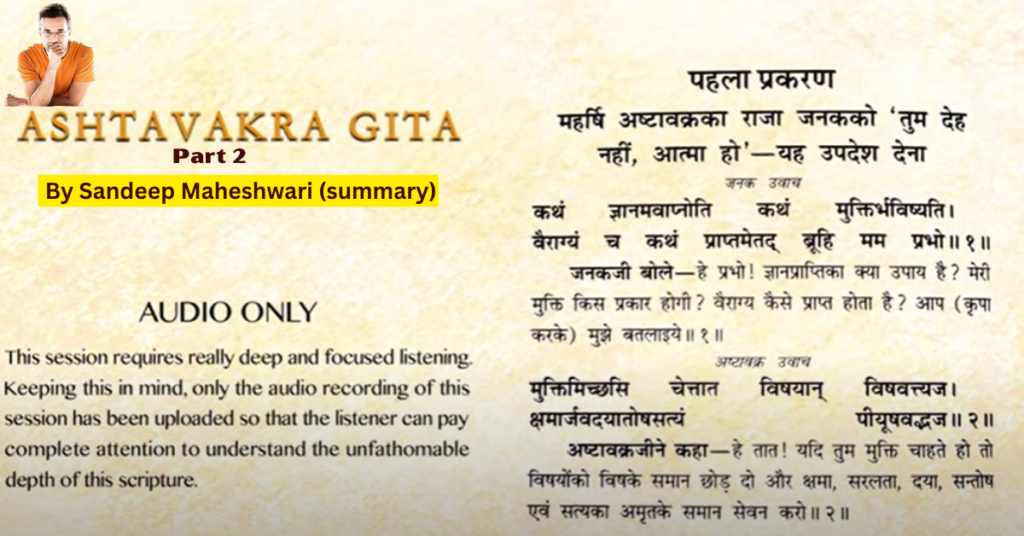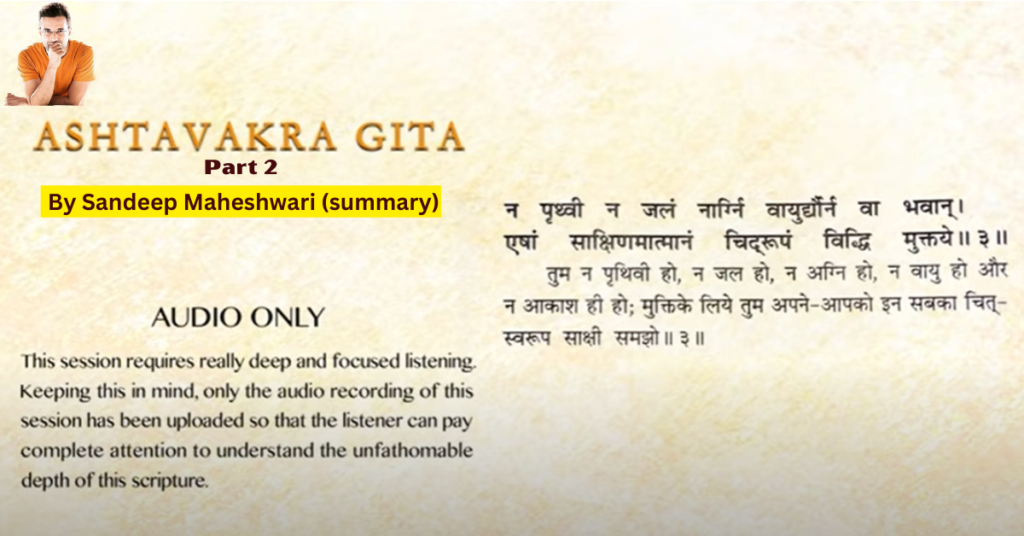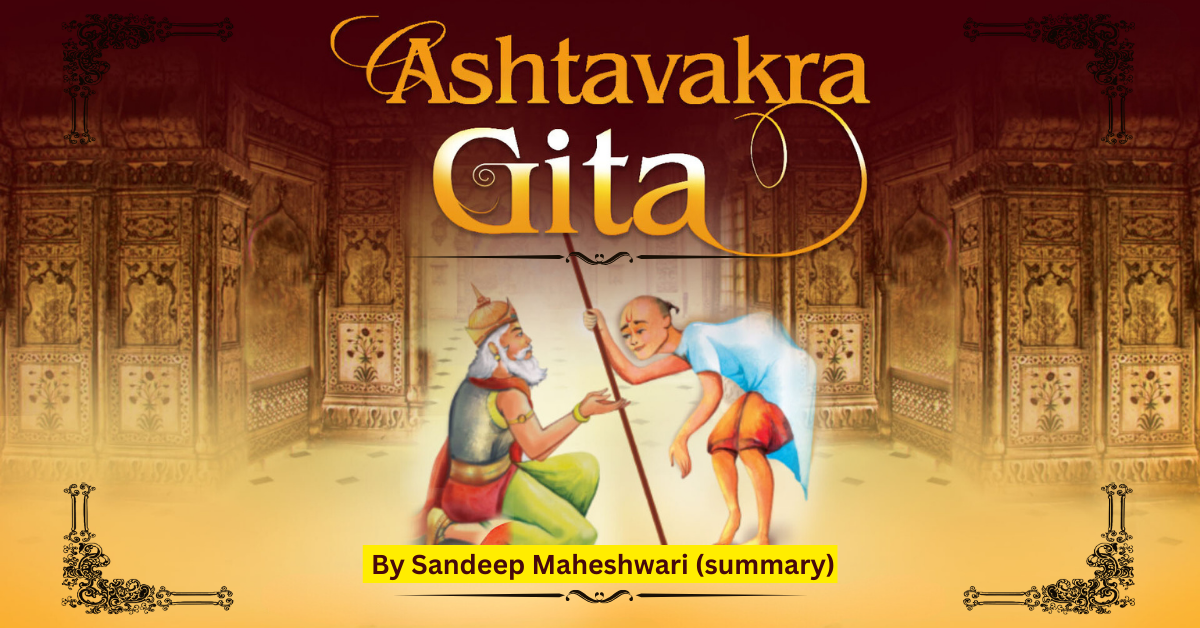ASHTAVAKRA GITA in English Part 2 By Sandeep Maheshwari
In this article, we will summarize our discussion from previous article (ASHTAVAKRA GITA Part 1) and then delve into King Janaka’s questions to Ashtavakra. Janaka sought answers on how to attain self-knowledge, find solutions to life’s challenges, and achieve liberation. These questions reveal a sense of honesty, as Janaka recognized the turmoil within his own mind and acknowledged the presence of fear and problems without clear solutions.

Seeking Self-Knowledge
In the pursuit of self-discovery and spiritual enlightenment, King Janaka once approached the revered sage Ashtavakra with a series of profound questions. These questions delved into the very essence of human existence: “How do I attain self-knowledge? What is the solution to the turmoil within me? And how can I achieve liberation?” King Janaka’s inquiries revealed a glimpse of his inner turmoil, acknowledging the disturbance within his mind, the fear he harbored, and the myriad problems he faced, for which he sought answers. Central to this quest was the concept of renunciation and the profound wisdom of Vairagya, which Ashtavakra Ji imparted.
Understanding Vairagya: The Path to Liberation
Ashtavakra Ji’s response to King Janaka’s quest for liberation was succinct yet profound: “If you seek salvation, relinquish the sense objects as if they were poison.” However, a common misinterpretation of this teaching led many to abandon their worldly possessions, duties, and relationships in a misguided pursuit of renunciation. Ashtavakra Ji’s message goes much deeper; it pertains to an inner renunciation, a detachment at the level of the mind rather than the physical world.
In essence, it calls for aligning all your actions, from dawn to dusk, with the pursuit of self-knowledge. This aligns with the fundamental teachings of ancient scriptures like the Vedas and Upanishads, which consistently emphasize the quest for self-realization. By connecting every aspect of life with self-knowledge, one treads the path to liberation.
Hence, the essence of Vairagya is not about external abandonment but internal detachment. It is the art of viewing all your actions, thoughts, and desires through the lens of self-awareness.

The Nuances of Forgiveness: A Deeper Insight
The concept of forgiveness is often misconstrued as a blanket absolution of all transgressions. However, Ashtavakra Ji’s wisdom introduces a more nuanced perspective. Forgiveness does not imply condoning heinous acts or enabling wrongdoing; it is about mastering the delicate balance between internal forgiveness and external action.
Forgiveness, in its true essence, signifies being free from the shackles of hatred. It means harboring no resentment or ill-will towards others. It acknowledges that individuals may act according to their nature, just as you do. However, if someone’s actions pose a significant threat or potential harm to others, taking appropriate external actions becomes a moral imperative.
In essence, forgiveness encourages strength on the outside while maintaining inner serenity. It means harboring no grudges or grievances and recognizing that holding onto resentment only impedes your own spiritual progress.
Embracing Simplicity: The Path to Clarity
Simplicity is a virtue often underestimated in the pursuit of self-realization. It involves perceiving things as they are, free from the complexities woven by the mind. Many individuals create intricate mental frameworks that entrap them in needless complications.
Consider anger, for example. Anger is not unique to humans; it is a universal emotion present even in animals. Accepting anger as a natural aspect of existence allows for simplicity. It means acknowledging that, like others, you too can experience anger when provoked. Simplifying life entails shedding the facade of self-righteousness and embracing your true nature.
The Paradox of Violence: Witnessing without Resistance
The concept of non-violence, or ahimsa, is often misunderstood. Attempting to suppress violent thoughts can lead to inner conflict. Ashtavakra Ji advises us to transcend this conflict by simply observing our violent tendencies without judgment. This awareness, rather than suppression, leads to transformation.
True kindness is not the absence of action but a compassionate understanding of others’ struggles. It entails putting oneself in their shoes, recognizing their humanity, and responding with empathy, even in challenging situations.
Contentment: The Ultimate Wealth on the Path to Self-Realization
Contentment is the greatest wealth on the path to self-realization. It signifies being at peace with what we have, regardless of its nature. In a world driven by perpetual desires and dissatisfaction, contentment is a rare gem.
We often seek external solutions to internal problems, believing that satisfaction lies in acquiring more. However, the truth is that no external acquisition can quench the inner thirst for contentment. The solution to our inner turmoil lies in recognizing that problems can never be entirely resolved. Solutions are relative, shaped by our limited knowledge and understanding. True contentment arises when we embrace everything in life, whether good or bad, as an integral part of our journey.
Truth: Unveiling Reality
The pursuit of truth demands that we see things as they are, free from preconceived notions. It challenges our self-perceptions and societal constructs. As Ashtavakra Ji guides Janaka, he dismantles the king’s illusions of identity.
Understanding that we possess both good and bad traits is essential. Claiming to be entirely good can blind us to our flaws. True honesty lies in acknowledging our dual nature.
We often define ourselves based on external labels and societal expectations. Yet, the truth lies beyond these constructs. It beckons us to see ourselves as the conscious witness of all experiences, transcending the limitations of body, mind, and ego.
The Witness Within
As Ashtavakra guides King Janaka towards self-discovery, he dismantles Janaka’s identifications with the elements of the material world. Earth, water, fire, wind, and space—all these are ruled out as his true essence. Instead, Janaka is urged to recognize himself as the conscious witness of all these elements.
This witness is not an external deity or a separate entity. It is our fundamental consciousness, the essence of life itself. It exists within every being and every atom of the universe, a silent observer of all that unfolds.
This transformational perspective offers liberation from the limitations of the mind. Janaka, and by extension, all seekers, are encouraged to shift their focus from the body and its associations to the underlying essence of consciousness. This shift liberates us from the chains of suffering and opens the doors to profound self-realization.
Conclusion
In our relentless pursuit of self-knowledge and liberation, we must learn to see ourselves as the conscious witnesses of all that unfolds in the universe. Abstinence, forgiveness, simplicity, kindness, contentment, and truth are not just abstract ideals but practical tools that empower us to navigate life’s complexities.
To truly understand these concepts, we must delve deep within ourselves, transcending the limitations of the material world. As we do so, we embark on a transformative journey that frees us from the shackles of suffering and leads us to the realm of self-realization.
In the end, the wisdom imparted by Ashtavakra to King Janaka serves as a timeless guide for all who seek to unlock the mysteries of the self and attain true liberation.
